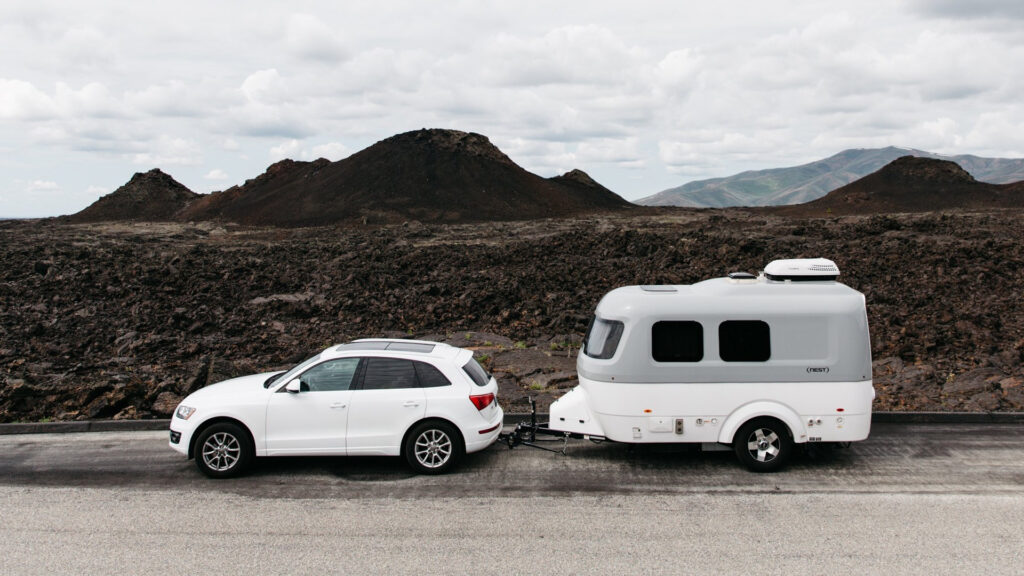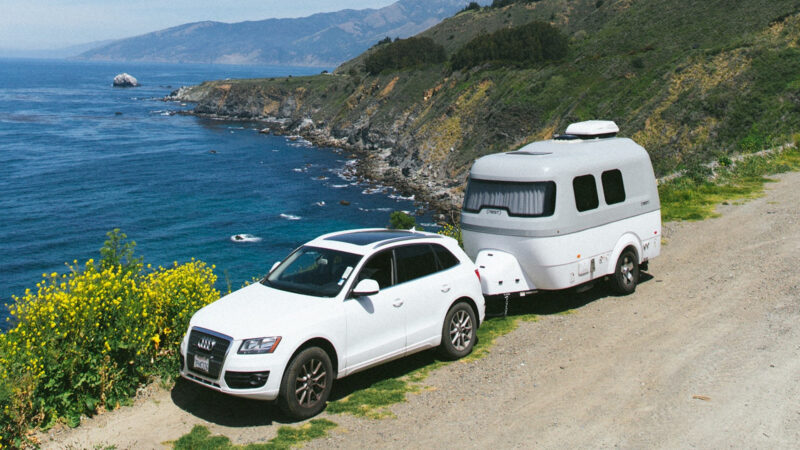Table of Contents Show
Airstream’s big push to step into the fiberglass camper market included the introduction of the Airstream Nest. Airstream has made a name for itself with its iconic aluminum RVs and campers, but a good business model is adaptable. The Nest was the company’s attempt at reformation.
However, less than three years after the Nest’s introduction, Airstream ended production. It seemed like the Nest would be the next big thing, so why would they stop manufacturing the model so quickly after launch? Let’s investigate.
What Is the Airstream Nest?
In 2016, Airstream began its journey with the Nest by purchasing the Nest Caravan Company. The design of the molded fiberglass camper was set to be Airstream’s answer to the shift in trends from aluminum to fiberglass.
The company needed a solid starting point for their long-awaited crossover adventure, and the Nest was the right player for the game. A small, simple, streamlined design made way for the Nest to fit right in with Airstream’s iconic and curvy flare.
About the Airstream Nest
The Airstream Nest is a fiberglass twist on the sleek bullet design of the well-known aluminum Airstream models. It has a distinctly European flair in interior and exterior design. Additionally, the Nest is a smaller, more compact design than some of the more well-known Airstream classics. Check out some of the specs below.

Specs
The Airstream Nest has two floorplans, but the build for the different layouts is the same. The Nest is 16 feet 7 inches long, and the exterior width of the trailer is 6 feet 10 inches. It weighs 3,400 pounds, and the maximum capacity allows for an extra 600 pounds. This travel trailer has a 24-gallon freshwater tank and a 30-gallon combo tank for gray and black water. It also has heating and air.
Features and Floorplan
The Nest has two similar floorplans. The main difference is that one has a stationary bed setup, while the other has a dinette that converts into a queen-sized sleeping area.
Overall, it comes with a small electric fridge, a standard microwave, a sink, and a two-burner stove in the kitchen. You’ll also find a full wet bath, a sizable closet, and tons of storage compartments. The interior has adjustable lighting, and it comes with an electric retractable awning on the exterior.
What Years Was Airstream Nest Made?
The Airstream Nest was first produced around 2018, and the company only produced the unit for a little over two years. By 2021, the Nest phased out. Of course, you can still purchase the camper on the secondary market, but the company no longer manufactures new ones.

Keep in Mind: Is it better to tow with a long bed or short bed? Click the link to look at which is really better!
Why Did Airstream Discontinue the Nest?
When it comes to a direct answer, there isn’t one. Airstream never publicly gave a formal reason for discontinuing production on the Nest. The best way to answer the question is with speculation based on what people have said about the model.
Forums and YouTube reviews of the camper point out a few pretty notable flaws in the design. The doors and window coverings break easily, and the trailer can’t carry much without overloading.
Additionally, it doesn’t come with many bells and whistles to justify the lofty price. Whatever the case, Airstream decided it was best to move on to something else.

How Much Does an Airstream Nest Cost?
A brand new Airstream Nest would cost $49,500, but pricing is a little tricky when the company takes the model out of commission. When looking up the Nest for sale on RV trader sites, you’ll quickly see that you’ll have to fork out anywhere from $40,000 to $60,000 to get your hands on a used Nest.
What Can Tow an Airstream Nest?
The Airstream Nest weighs around 3,700 pounds, not including the additional weight when loaded. The best way to ensure you’ve got the right truck for the job is to check the vehicle’s towing specs. Any car that can tow around 4,000 pounds can do the job. Most SUVs and trucks can handle towing this weight range.
Do Airstreams Retain Their Value?
Airstreams are very well known for their ability to last. These quality campers have a longstanding reputation, and the name helps to give any Airstream you purchase a leg up on the market. You won’t have to worry about too much depreciation when you invest in an Airstream camper. You will find a good resale market for almost all of their models.

Keep in Mind: Airstream RVs aren’t cheap! But Why Are Airstreams So Expensive? Let’s take a look and find out!
Is a Used Airstream Nest Worth Buying?
When you think about the circumstances surrounding the Airstream Nest, it might be worth purchasing a used one. The value of this short-lived design will likely rise due to the slim supply. Only time will tell, but the camper isn’t bad either. However, the pricing is quite high for the size. It comes down to what you hope to get out of the deal. Now that you know a little about the Airstream Nest, do you think it’s worth buying?







No, I don’t think it’s worth buying. It’s a very nice little camper, but, it’s NOT an investment. It will not go up in value. Plus, it’s an orphaned product, with limited production and parts and accessories will be very limited for this unit.
It’s true that fiberglass composite trailers are great, but, over time delamination can setup and cracking if it’s not taken care of which will be very expensive to deal with.
I had a small fiberglass composite teardrop trailer and within four years I could see the beginning of delamination starting to occur. Plus, towing a trailer and backing up on something this small is tricky; there’s a lot of squirrelly wiggle on a unit this small.
Finally, there’s the issue of total weight capacity on the unit.
Don’t just dismiss this lightly. Weight capacity is extremely important when you want to get out and carry the necessary water and gear with you. I think weight capacity is a seriously overlooked feature on RVs. Of course, don’t assume that any SUV can easily pull this almost 4,000 pound trailer. This is a huge mistake especially when going into the mountains and climbing steep grades.
It’s easy to dump the black and gray water tank on a Class B motorhome, but, dumping this little trailer while dry camping means you have to pack everything up or carry your own “honey wagon” cart…… yuck. I can’t see this as a cross country vehicle.
Finally, the price of $50,000 or even $40,000 used doesn’t sound appealing to me….
The problem with the Nest was that other fiberglass campers that had been around for a long time offered many more features for less money. Even the luxury fiberglass Oliver, that was close to its price range, was 2 and a half feet longer. Casitas, Scamps, and Canadian Escapes are much cheaper and weigh less for the size range. They banked too much on the Airstream name to justify the price and were direct competition for their own Basecamp model.
The Nest is beloved by those who own one. The article overstates the price point, we purchased ours in 2019 at $39000, well below the $45000 listed price, of course that was before pandemic inflated pricing. Nonetheless a used Nest runs 30-35K these days. In our experience it is high quality and always an attention getter. No serious problems with 28,000 miles thus far. We are Airstream people so have that bias. As to why they discontinued (another opinion), the quality could not be cut to a profitable point especially with the Basecamp selling so well to a different set of buyers. Yes Olivers are in same group (like those also) but the niche Nest is more upscale in style. Although did not purchase as an investment I would think in time it will be valued for what it is/was.